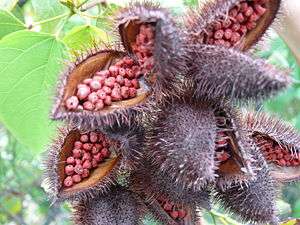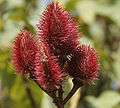Bixa orellana
| Achiote | |
|---|---|
| Achiote seed pods | |
| Scientific classification | |
| Kingdom: | Plantae |
| Clade: | Angiosperms |
| Clade: | Eudicots |
| Clade: | Rosids |
| Order: | Malvales |
| Family: | Bixaceae |
| Genus: | Bixa |
| Species: | B. orellana |
| Binomial name | |
| Bixa orellana | |
| Synonyms[1] | |
| |
Achiote (Bixa orellana) is a shrub or small tree originating from the tropical region of the Americas.[2] North, Central, and South American natives originally used the seeds to make red body paint and lipstick, as well as a spice.[2] For this reason, the achiote is sometimes called the lipstick tree.
The tree is best known as the source of annatto, a natural orange-red condiment (also called "achiote" or "bijol") obtained from the waxy arils that cover its seeds.[2] The ground seeds are widely used in traditional dishes in Central and South America, Mexico, and the Caribbean, such as cochinita pibil, chicken in achiote and caldo de olla. Annatto and its extracts are also used as an industrial food coloring to add yellow or orange color to many products such as butter, cheese, sausages, cakes, and popcorn.
The species name was given by Linnaeus after the Spanish conquistador Francisco de Orellana, an early explorer of the Amazon River.[3] The name achiote derives from the Nahuatl word for the shrub, āchiotl [aːˈt͡ʃiot͡ɬ]. It may also be referred to as aploppas, or by its original Tupi name uruku, urucu or urucum ("red color"), which is also used for the body paint prepared from its seeds.
Description
Bixa orellana is a tall shrub to small evergreen tree 6–10 m (20–33 ft) high.[2][4] It bears clusters of 5 cm (2 in) bright white to pink flowers, resembling single wild roses, appearing at the tips of the branches.[4] The fruits are in clusters: spiky looking red-brown seed pods covered in soft spines. Each pod contains many seeds covered with a thin waxy blood-red aril. When fully mature, the pod dries, hardens, and splits open, exposing the seeds.[4] The red color of the seed coats is due mainly to the carotenoid pigments, bixin and norbixin.[5]
Distribution
Although the exact origin of B. orellana is unknown, it is native to the American tropics: "it is said to be indigenous by Seemann on the northwest coast of Mexico and Panama, by Triana in New Granada, by Meyer in Dutch Guiana, and by Piso and Claussen in Brazil”.[2] B. orellana is found in substantial wild and cultivated acreages from Mexico to Ecuador, Brazil, and Bolivia.[4]
During the 16th and 17th centuries, annatto was distributed to Southeast Asia, Africa, the Caribbean, and southeastern North America in tropical and subtropical regions.[2][4] It became cultivated in tropical regions of Asia, such as India, Sri Lanka, and Java mainly for the dye which the seeds yield.[2]
Cultivation


Bixa orellana is grown easily and quickly in frost-free regions, from subtropical to tropical climates, and sheltered from cool winds. It prefers year-round moisture, good drainage, and moderately fertile soil in full sun or partial shade. It can be propagated from seed and cuttings. Cutting-grown plants flower at a younger age than seedlings.[6]
The main commercial producers are countries in South America, Central America, the Caribbean, Africa, India, and Sri Lanka, where it was introduced by the Spanish in the 17th century. Production statistics are not usually available, and would not provide a reliable guide to international trade since many of the producing countries use significant quantities domestically (e.g., Brazil is a large producer and consumer, needing additional imports). Annual world production of dried annatto seed at the beginning of the 21st century was estimated at about 10,000 tons, of which 7,000 tons enter international trade. Peru is the largest exporter of annatto seed, annually about 4,000 tons; Brazil the largest producer with about 5,000 tons. Kenya exports annually about 1,500 tons annatto seed and extracts and is the second-largest exporter, after Peru. Côte d'Ivoire and Angola are also exporters.[7]
Industrial uses
Before synthetic dyes revolutionized industry, the tree was planted commercially for the pigment, extracted by solvent or boiling the seeds in oil, which was used to color cheese, margarine, chocolate, fabric and paints. Annatto oil is rich in tocotrienols, beta-carotene, essential oil, saturated and unsaturated fatty acids, flavonoids and vitamin C.[8] The seeds are collected from wild-growing bushes or from plantations in Latin America, Africa, and Asia.
Culinary uses
Ground B. orellana seeds are often mixed with other seeds or spices to form a paste or powder for culinary use especially in Latin American, Jamaican, Chamorro, and Filipino cuisines. The seeds are heated in oil or lard to extract its dye and flavor for use in dishes and processed foods such as cheese, butter, soup, gravy, sauces, cured meats, and other items. The seeds impart a subtle flavor and aroma and a yellow to reddish-orange color to food. The seeds are used to color and flavor rice instead of the much more expensive saffron.
In Brazil, a powder known as colorau or colorífico is made from the ground seeds combined with filler seeds like maize. This powder is similar to and sometimes replaces paprika.[9]
The Yucatecan condiment called recado rojo or "achiote paste" is made from ground seeds combined with other spices. It is a mainstay of the Mexican and Belizean cuisines.
A condiment called sazón is commonly used in Spanish, Latin American, and Caribbean cuisine for meats and fish. Sazón is made from achiote (annatto) seeds, cumin, coriander seeds, salt, and garlic powder. The Spanish word sazón means "season" or "seasoning".
Traditional medicine
The tree has been used in folk medicine practices of India, where different parts of the plant are thought to be useful as therapy.[10]
Other uses
Achiote has long been used by American Indians to make a bright red paint for the body and hair. Body-painting with urucu remains an important tradition of many Brazilian native tribes. It was reportedly used for body paint among the native Taínos in Borinquen, Puerto Rico. The use of achiote hair dye by men of the Tsáchila of Ecuador is the origin of their Spanish name, the Colorados. The Aztec people of Mexico used achiote seeds as source of a red ink for manuscript painting in the 16th century.[11]
The plant is valued for its stem fibre (used in rope mats) and an adhesive gum which is extracted from all parts.[12][13][14] Traditionally in Nepal, the plant has been used to make sindoor.[15]
Gallery
 With fruits in Hyderabad, India
With fruits in Hyderabad, India Fruit in Hyderabad, India
Fruit in Hyderabad, India_seeds.jpg) Split seed pod
Split seed pod Flower closeup
Flower closeup Fruit
Fruit
References
- ↑ Kew World Checklist of Selected Plant Families
- 1 2 3 4 5 6 7 Julia F Morton (1960). "Can Annatto (Bixa orellana, L.), an old source of food color, meet new needs for safe dye?". Proceedings of the Florida State Horticultural Society. 73: 301–309. Retrieved 10 October 2018.
- ↑ Levy, Luis W.; Rivadeneira, Diana M. (2000). "Annatto". In Lauro, Gabriel J.; Francis, F. Jack. Natural Food Colorants Science and Technology. IFT Basic Symposium Series. New York: Marcel Dekker. p. 115. ISBN 978-0-8247-0421-6.
- 1 2 3 4 5 "Bixa orellana (annatto)". Center for Agriculture and Biosciences International (CABI). 27 September 2018. Retrieved 10 October 2018.
- ↑ Ul-Islam, S; Rather, LJ; Mohammad, F (2015). "Phytochemistry, biological activities and potential of annatto in natural colorant production for industrial applications – A review". Journal of Advanced Research. 7 (3): 499–514. doi:10.1016/j.jare.2015.11.002. PMC 4856788. PMID 27222755.
- ↑ Lord, Tony (2003) Flora : The Gardener's Bible : More than 20,000 garden plants from around the world. London: Cassell. ISBN 0-304-36435-5
- ↑ Jansen, P.C.M. (2005). Jansen, P.C.M.; Cardon, D., eds. "Bixa orellana L." PROTA 3: Dyes and tannins/Colorants et tanins. PROTA. Archived from the original on 20 Nov 2008. Retrieved 5 Oct 2014.
- ↑ Ângela de Almeida Meireles, Maria; Lima Cavalcante de Albuquerque, Carolina. "Processo otimizado para obtenção de óleo rico em antioxidantes de urucum" (PDF). Inova (in Portuguese). Unicamp. Retrieved 2 Jun 2015.
- ↑ "New Crops from Brazil". Purdue University. 1990. Retrieved 24 August 2011.
- ↑ Khare, C.P. (2007). Indian Medicinal Plants. New York: Springer Science+Business Media, LLC. ISBN 978-0-387-70638-2.
- ↑ "Colorants Used During Mexico's Early Colonial Period". Stanford University. 1997. Archived from the original on March 20, 2008. Retrieved 24 August 2011.
- ↑ Ellison, Don (1999) Cultivated Plants of the World. London: New Holland (1st ed.: Brisbane: Flora Publications International, 1995)
- ↑ Graf, Alfred Byrd (1986) Tropica: color cyclopedia of exotic plants and trees for warm-region horticulture--in cool climate the summer garden or sheltered indoors; 3rd ed. East Rutherford, N.J.: Roehrs Co
- ↑ Macoboy, Stirling (1979) What Tree is That?, Sydney, Australia (1st ed.: Sydney: Ure Smith). ISBN 0-7254-0480-9
- ↑ Manandhar, N. P. (2002). Plants and People of Nepal. Portland, OR: Timber Press. p. 113. ISBN 9780881925272.
| Wikimedia Commons has media related to Bixa orellana. |